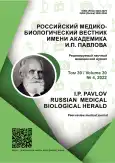Variant Anatomy of the Right Ventricular Moderator Band in Human Heart in Early Antenatal Period of Development
- Authors: Yakimov A.A.1,2
-
Affiliations:
- Ural State Medical University
- Ural Federal University
- Issue: Vol 30, No 4 (2022)
- Pages: 447-456
- Section: Original study
- URL: https://journal-vniispk.ru/pavlovj/article/view/252583
- DOI: https://doi.org/10.17816/PAVLOVJ106689
- ID: 252583
Cite item
Abstract
INTRODUCTION: The information about the variants of the structure and topography of the moderator band (MB) that connects the interventricular septum with the anterior papillary muscle and the anterior wall of the right ventricle in the heart of a fetus and a newborn, is of great importance for cardiac surgery.
AIM: To establish the prevalence of the MB and describe the variants of its shape, structure and position in the right ventricle of the normal human heart in the early antenatal period of development.
MATERIALS AND METHODS: Using Olympus SZX2-ZB10 stereomicroscope with 4.725X to 15X magnification, formalin-fixed hearts of fetuses and stillborns of 17–28 weeks were studied. The results are presented in the form of median, 25th and 75th percentiles, extreme values. Correlation analysis was performed. Significance of the difference of proportions was evaluated by one-sided t-test. The results are presented in the form of median (Me), 25th and 75th percentiles (Q25%–Q75%).
RESULTS: MB was found in 73 of 90 preparations (81.1%), in 48 cases (66%) it was bridge-like, and in 24 of 72 (33.3%) ― parietal. MB had flattened (crest-like) or cylindrical shape (62.5% vs 33%; p = 0.0002). The most common was flattened bridge-like variant. The length of MB was 2.2 (1.75–3.0) mm, width 1.35 (0.9–1.75) mm, thickness 1.0 (0.65–1.5) mm. The band mainly originated from the interventricular septum between the middle and apical thirds of the longitudinal axis, and the anterior and middle thirds of the transverse axis of the interventricular septum. It typically terminated with the attachment to the anterior papillary muscle (47.7%), or to the anterior wall of the right ventricle immediately in front of this muscle (38.5%). In 22.2% of cases, the MB had papillary muscles on it, and in 37.5%, the secondary trabeculae extended from it to the apex of the ventricle.
CONCLUSION: MB is a normal, but not obligatory structure of the heart in the antenatal period, its normal anatomy is variable and is manifested by typical and rare variants of the form, position, beginning and end, which in many cases can impede diagnostics and treatment of the pathology of the right ventricle.
Full Text
##article.viewOnOriginalSite##About the authors
Andrey A. Yakimov
Ural State Medical University; Ural Federal University
Author for correspondence.
Email: ayakimov07@mail.ru
ORCID iD: 0000-0001-8267-2895
SPIN-code: 8618-2991
MD, Cand Sci. (Med.), Associate Professor
Russian Federation, Ekaterinburg; EkaterinburgReferences
- Yakimov AA Trabeculae and intertrabecular spaces of the interventricular septum: anatomical structure and development. Morphologiia. 2009;135(2):83–90. (In Russ).
- Kosiński A, Nowiński J, Kozłowski D, et al. The crista supraventricularis in the human heart and its role in the morphogenesis of the septomarginal trabecula. Annals of Anatomy. 2007;189(5):447–56. doi: 10.1016/j.aanat.2007.01.008
- Bandeira STF, Wafae GC, Ruiz C, et al. Morphological classification of the septomarginal trabecula in humans. Folia Morphologica. 2011; 70(4):300–4.
- FIPAT. Terminologia Anatomica. 2nd ed. FIPAT.library.dal.ca Federative International Programme for Anatomical Terminology; 2019. Pt. 4.
- Anderson RH, Spicer DE, Hlavacek AM, et al. Wilcox's Surgical Anatomy of the Heart. 4th ed. Moscow: Logosfera; 2015.
- Fal'kovskiy GE. Stroyeniye serdtsa i anatomicheskiye osnovy ego funktsii. Materialy kursa lektsiy. Moscow: Nauchnyy tsentr serdechno-sosudistoy khirurgii imeni A.N. Bakuleva; 2014. (In Russ).
- Yakimov AA. Anatomical characteristics of septomarginal trabecula of the right ventricle of the human fetal heart. Morphologiia. 2016;150(4): 59–64. (In Russ).
- Picazo–Angelin B, Zabala–Argüelles JI, Anderson RH, et al. Anatomy of the normal fetal heart: The basis for understanding fetal echocardiography. Annals of Pediatric Cardiology. 2018;11(2):164–73. doi: 10.4103/apc.APC_152_17
- Loukas M, Housman B, Blaak C, et al. Double-chambered right ventricle: A review. Cardiovascular Pathology. 2013;22(6):417–23. doi: 10.1016/j.carpath.2013.03.004
- Walton RD, Pashaei A, Martinez ME, et al. Compartmentalized structure of the moderator band provides a unique substrate for macroreentrant ventricular tachycardia. Circulation. Arrhythmia and Electrophysiology. 2018;11(8):e005913. doi: 10.1161/CIRCEP.117.005913
- Loukas M, Klaassen Z, Tubbs RS, et al. Anatomical observations of the moderator band. Clinical Anatomy. 2010;23(4):443–50. doi: 10.1002/ca.20968
- Lee J–Y, Hur M–S. Morphological classification of the moderator band and its relationship with the anterior papillary muscle. Anatomy & Cell Biology. 2019;52(1):38–42. doi: 10.5115/acb.2019.52.1.38
- Kosiński A, Zajączkowski M, Kuta W, et al. Septomarginal trabecula and anterior papillary muscle in primate hearts: developmental issues. Folia Morphologica. 2013;72(3):202–9. doi: 10.5603/FM.2013.0034
- Meetham K, Taerujjirakul T, Garitjirapath N, et al. The morphometric study of the moderator band in Thais. Anatomical Science International. 2022;97(2):188–96. doi: 10.1007/s12565-021-00641-8
- Kosiński A, Kozłowski D, Nowiński J, et al. Morphogenetic aspects of the septomarginal trabecula in the human heart. Archives of Medical Science. 2010;6(5):733–43. doi: 10.5114/aoms.2010.17089
- Rocha H, Eliziário LFE, Wafae GC, et al. Anatomy of the septomarginal trabecula in Landrace pig hearts. Morphologie. 2010;94(305):26–9. doi: 10.1016/j.morpho.2010.03.004
- Nascimento SRR, Ruiz CR, Nunes M, et al. Histomorphometry and Stereological Study of Septomarginal Trabecula in Pig's Heart. Journal of Morphological Sciences. 2021;38:309–14. doi: 10.51929/jms.38.53.2021
- Raghavendra AY, Kavitha, Arunachalam Kumar, et al. Anatomical study of the moderator band. Nitte University Journal of Health Science. 2013;3(4):78–81. doi: 10.1055/s-0040-1703707
- Zajączkowski M, Kosiński A, Grzybiak M, et al. The structure of the vascular system of the septomarginal trabecula in the heart of an adult. Advances in Clinical and Experimental Medicine. 2018;27(5):623–31. doi: 10.17219/acem/68692
- Jeżyk D, Duda B, Jerzemowski J, et al. Positions of septal papillary muscles in human hearts. Folia Morphologica. 2010;69(2):101–6.
Supplementary files









